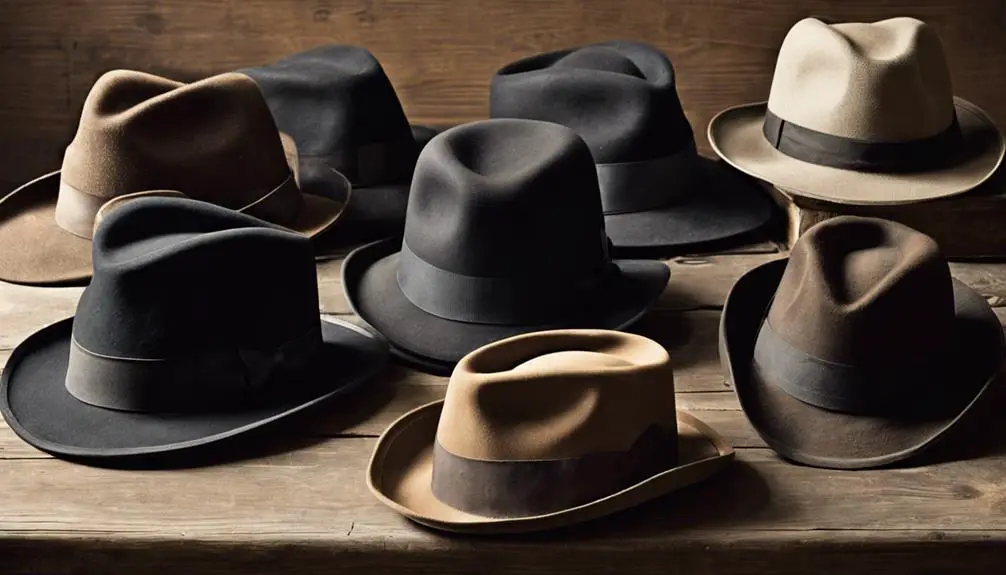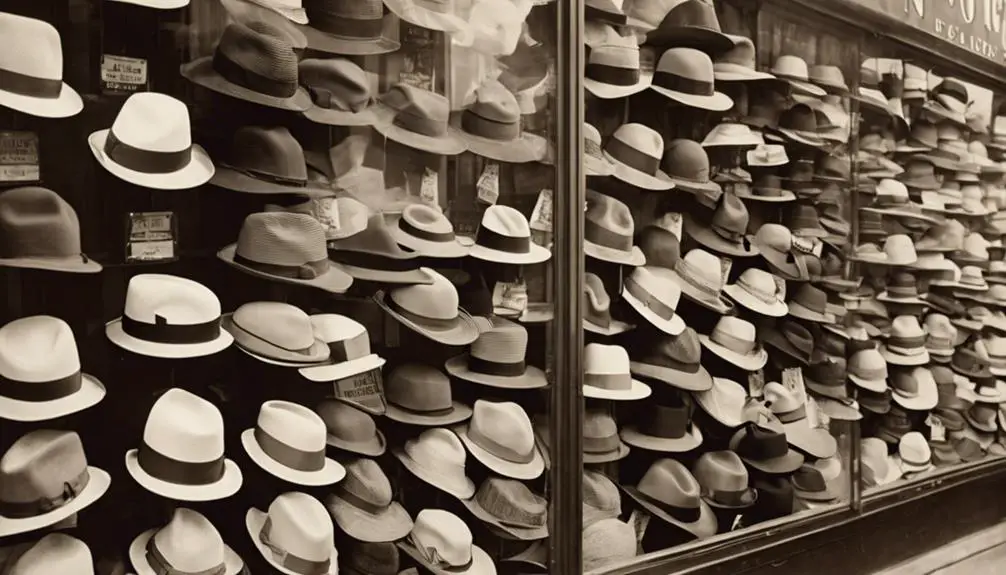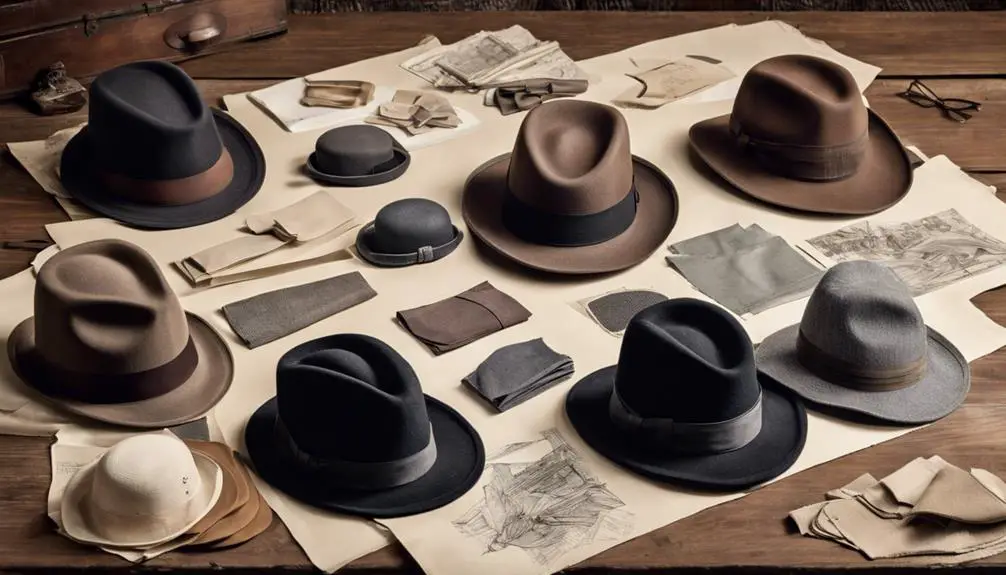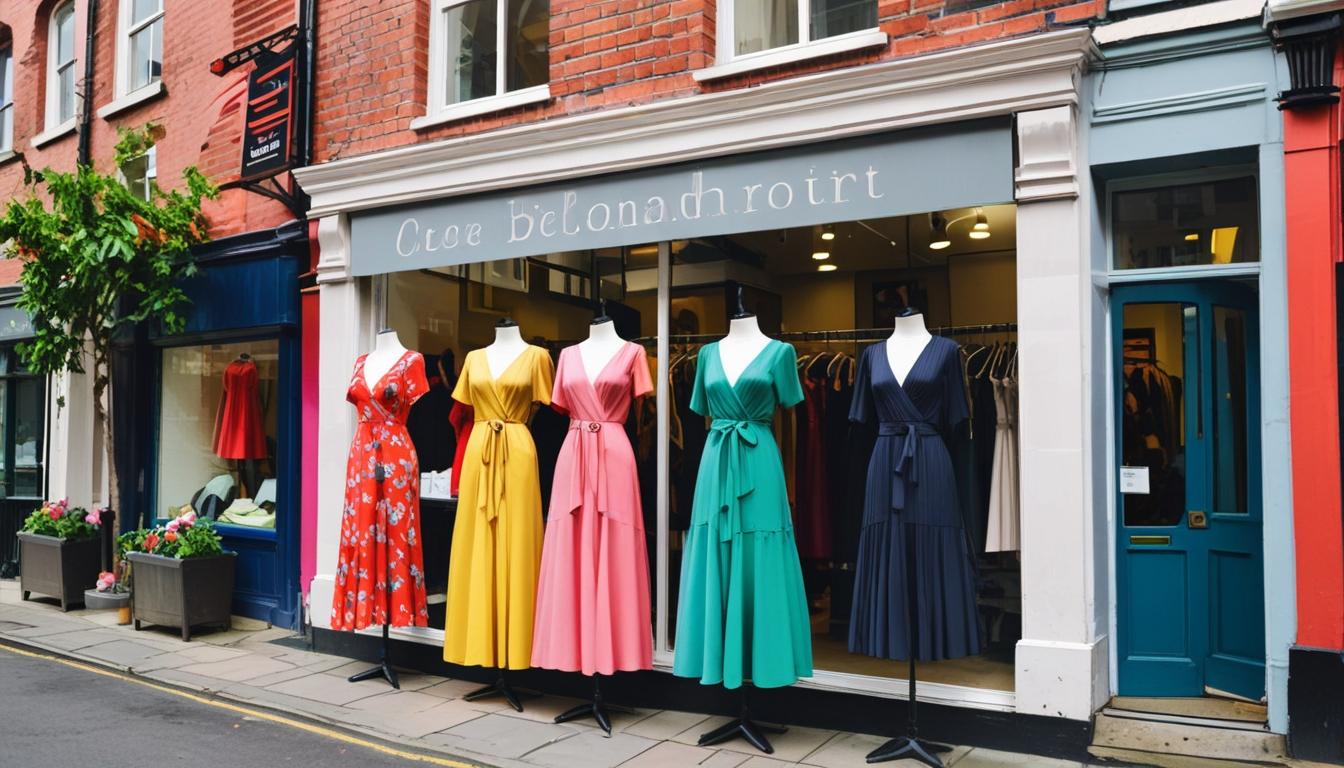Men's hats in the 1930s were essential to expressing personal identity and social status. You'd find classic styles like the fedora, homburg, and newsboy cap dominating the scene. The fedora, soft and brimmed, became iconic, often linked to Hollywood's leading men. Homburgs exuded elegance, while practicality drove the popularity of newsboy caps. Material choices ranged from durable felt to cozy tweed, reflecting both quality and function. The impact of the Great Depression shaped fashion, pushing for understated designs. Each hat style told a story, intertwining with the era's culture. Discovering their influence on today's fashion is truly fascinating.
Types of 1930s Men's Hats

In the 1930s, men's hats served not just as functional accessories but as essential components of personal style and social identity. Among the diverse styles included the fedora, characterized by its wide brim and pinched crown, typically crafted from soft fur felt in muted colors like dark brown, grey, and navy blue. The Homburg, with its tall crown and curled brim, was favored by older gentlemen and often associated with gangsters, appearing in medium grey and black.
Another notable style was the Bowler Hat, or Derby, featuring a rounded crown and narrow brim, made from hard felt. This hat suited formal settings, commonly found in classic black or brown hues. For more casual outings, the Newsboy Cap stood out with its 8/4 panel design and small stiff brim, available in wool and tweed, often showcasing plaid or check patterns. Finally, the Ivy Cap, or flat cap, gained traction during this decade for its relaxed style, typically made from tweed or wool, perfect for everyday wear. Each of these 1930s men's hats not only completed an outfit but also conveyed a distinct social message and personal flair.
Notable Brands and Collections
The world of 1930s men's hats is beautifully represented by several notable brands and collections that blend historical craftsmanship with timeless elegance. The Bollman Collection stands out with its dedication to vintage style 1930s mens hats, offering classic designs like the Trilby and Topper. Each piece reflects meticulous attention to detail and quality materials, ensuring authenticity and aesthetic appeal.
Wonderful Fashion has carved a niche with its classic herringbone tweed designs, prominently featured in newsboy caps during this era. Their pieces embody the spirit of the time, merging practicality with style. Meanwhile, BOTVELA specializes in wool blend and linen newsboy caps, providing options that resonate with the vintage aesthetic, perfect for those seeking comfort and style.
Jaxon & James introduces a unique twist with their Tyrolean hats and striped band skimmers, catering to those who appreciate both traditional and modern flair. Finally, Stacy Adams is renowned for its high-quality wool felt hats, particularly their fedora hats and homburgs, capturing the elegance and sophistication of 1930s menswear. Together, these brands offer a rich tapestry of styles that define an iconic era in fashion.
Price Range of Hats

Understanding the price range of 1930s men's hats provides insight into the fashion landscape of the era and reflects the craftsmanship behind each piece. The prices varied greatly based on style and quality, catering to different budgets and tastes.
Here's a breakdown of the price ranges for various hat styles:
| Hat Style | Price Range |
|---|---|
| Fedora | $60 – $110 |
| Newsboy Caps | $30 – $100 |
| Bowler Hats | Around $200.54 |
| Budget-Friendly | From $39.99 |
Fedora prices, for instance, could reach up to $110, especially for exclusive styles like the Curtis Limited Edition Fedora, priced at $73.50. Newsboy caps offered more affordable options, appealing to a broader audience, while high-quality Bowler hats were seen as a luxury item. For those seeking budget-friendly choices, the Big Boss Homburg provided a stylish alternative without breaking the bank.
This diversity in pricing not only illustrates the range of choices available but also highlights the importance of hats in men's fashion during the 1930s. Each piece told a story of individuality and social status.
Materials Used in Hat Making
Hats from the 1930s showcase a rich variety of materials, each selected for its unique properties and aesthetic appeal. Felt, primarily made from wool or rabbit fur, became the go-to for formal hats like fedoras and bowlers. Its warmth and durability offered not just protection but also a polished look for the dapper gentleman.
In contrast, straw, particularly in the form of the Panama hat, was favored during the summer months. Lightweight and breathable, it provided comfort in warm weather, making it an essential accessory for leisure strolls or outdoor events. For those seeking luxury, beaver fur stood out as an exquisite choice, prized for its softness and resilience, lending an air of sophistication to high-end styles.
On the more casual side, tweed found its place in newsboy caps. It mixed classic aesthetics with warmth and texture, often featuring unique patterns that added character. Ultimately, cotton emerged as a practical material for everyday hats, prioritizing comfort and ease of maintenance for men on the go. Each material not only reflected the era's fashion sensibilities but also catered to the diverse lifestyles of men in the 1930s.
Influential Fashion Icons
Fashion icons of the 1930s played a significant role in shaping men's hat styles, further elevating their status within popular culture. These influential figures not only showcased their unique tastes but also created trends that resonated with the masses. Here are three key icons who left an indelible mark on men's hats during this era:
- Clark Gable: Often seen in a fedora, Gable brought sophistication to Hollywood films, making this style synonymous with suave menswear.
- Cary Grant: Known for his impeccable style, Grant frequently wore homburg hats, which became a staple for men seeking elegance and refinement.
- Humphrey Bogart: With his tough-guy persona, Bogart's regular use of fedoras solidified the hat's association with masculinity and coolness, influencing countless men.
Additionally, Bing Crosby and Frank Sinatra contributed to the fedora's legendary status, showcasing it in performances and public appearances. Each of these icons not only defined their fashion style but also transformed the perception of men's hats, making them essential accessories in the world of 1930s fashion.
Cultural Impact of Hats
The cultural significance of men's hats in the 1930s went far beyond mere accessories; they became integral to personal identity and social status. During this period, men's hat styles included the fedora and the homburg, which were favored by influential figures like Clark Gable and Cary Grant. These hats not only elevated an outfit but also symbolized sophistication and power, aligning with the aspirations of many during the Golden Hollywood era.
The film industry played an essential role in shaping fashion trends, as iconic stars showcased specific styles on the big screen. This visibility helped associate certain hats with particular social classes; for example, the bowler hat was a staple for the upper class, while the newsboy cap represented the working class. The Great Depression brought about a shift toward more practical, modest aesthetics, mirroring the somber national mood.
Hats became cultural symbols, epitomizing masculinity and personal style. However, as the decade progressed, their decline in popularity marked a significant change in men's fashion, evolving from essential fashion statements to mere relics of a bygone era.
Evolution of Hat Fashion

Shifting from the extravagant styles of the previous decade, men's hat fashion in the 1930s embraced practicality and understated elegance. Economic hardships from the Great Depression influenced this change, leading to a focus on more modest designs. The styles of the era reflected the changing social dynamics, with certain hats becoming iconic symbols of sophistication.
Key styles that defined this decade included:
- Fedora: Often associated with Hollywood icons like Humphrey Bogart, it symbolized sophistication and became a staple in men's fashion.
- Homburg: With its formal elegance, this hat was frequently worn by men in professional and social settings, representing status.
- Bowler (Derby): Known for its rounded crown and stiff brim, the Bowler offered a distinctive look, popular in urban environments.
Color trends during this era favored rich hues like hunter green, medium blue, and classic browns and greys, enhancing the visual appeal of hats for men. However, as the late 1930s approached, the decline of hat-wearing began, signaling a move toward more casual styles that would dominate the following decades.
Historical Context of Fashion
While economic struggles defined the 1930s, they also shaped the fashion landscape in profound ways, influencing not just what men wore but how they perceived their style. The Great Depression prompted a shift toward practicality and durability, particularly in accessories like men's hats. Hollywood stars, such as Clark Gable and Cary Grant, popularized specific styles, transforming them into essential elements of men's fashion.
| Hat Style | Characteristics | Influence |
|---|---|---|
| Classic Fedora | Wide brim, structured crown | Popularized by stars |
| Homburg | Formal, rounded crown | Associated with elegance |
| Newsboy Cap | Soft, rounded cap | Casual, practical wear |
| Bowler | Hard felt, rounded top | Iconic British style |
The decline of extravagant fashion led to more modest designs, reflecting the somber national mood. Men gravitated towards affordable, stylish options that maintained an air of sophistication. This era marked a change in men's fashion, emphasizing tailored looks and classic styles that conveyed resilience and elegance, even amid hardship. The 1930s men's hats encapsulated this blend of practicality and style, leaving a lasting impact on fashion history.
Modern Availability and Tips

As interest in vintage fashion surges, especially among those drawn to the elegance of the 1930s, modern availability of men's hats reflects this revival. Today, you can find a wide array of retro-inspired hats and caps complete with classic styles like fedoras and newsboy caps. Various retailers cater to enthusiasts, offering both authentic and reproduction vintage hats.
When shopping for these stylish hats, consider the following tips:
- Check Sizing: Modern styles of hats may differ in fit from historical models, so consult sizing charts and product reviews to guarantee a perfect match.
- Look for Deals: Many retailers offer free shipping on larger orders (usually over $99), which can help you save when buying multiple items.
- Join Rewards Programs: Engaging in a retailer's rewards program lets you earn points for discounts or exclusive items, enhancing your shopping experience.
With this modern availability, you can easily incorporate the timeless appeal of 1930s hats into your wardrobe while enjoying the benefits of contemporary shopping conveniences.
Frequently Asked Questions
What Kind of Hats Did Men Wear in the 1930s?
In the 1930s, you'd notice men donning stylish hats like fedoras, bowlers, and homburgs. Each design reflected status and personality, with materials varying from soft felt to lightweight straw, showcasing their fashion sense and practicality.
What Would Men Wear in the 1930s?
In the 1930s, you'd see men sporting various stylish headgear. Choices ranged from the sophisticated bowler to the casual newsboy cap, each reflecting personal taste, social status, and the era's unique fashion trends.
What Were the Names of Men's Hats in the 1940s?
In the 1940s, you'd encounter various hat styles like the fedora, homburg, and bowler. Each offered unique flair, catering to different occasions, while practical options like newsboy caps emerged, reflecting shifting fashion sensibilities during that era.
What Was the Great Depression Hat Called?
During the Great Depression, hats like the fedora symbolized resilience and practicality. You'll find that these styles reflected the era's challenges, blending fashion with functionality, allowing men to maintain dignity amid economic struggles.





E2Bet
Blog Comment: One of the few betting platforms I trust in Pakistan.
E2Bet offers great security, and their payment methods are safe and reliable.
A 10/10 experience!